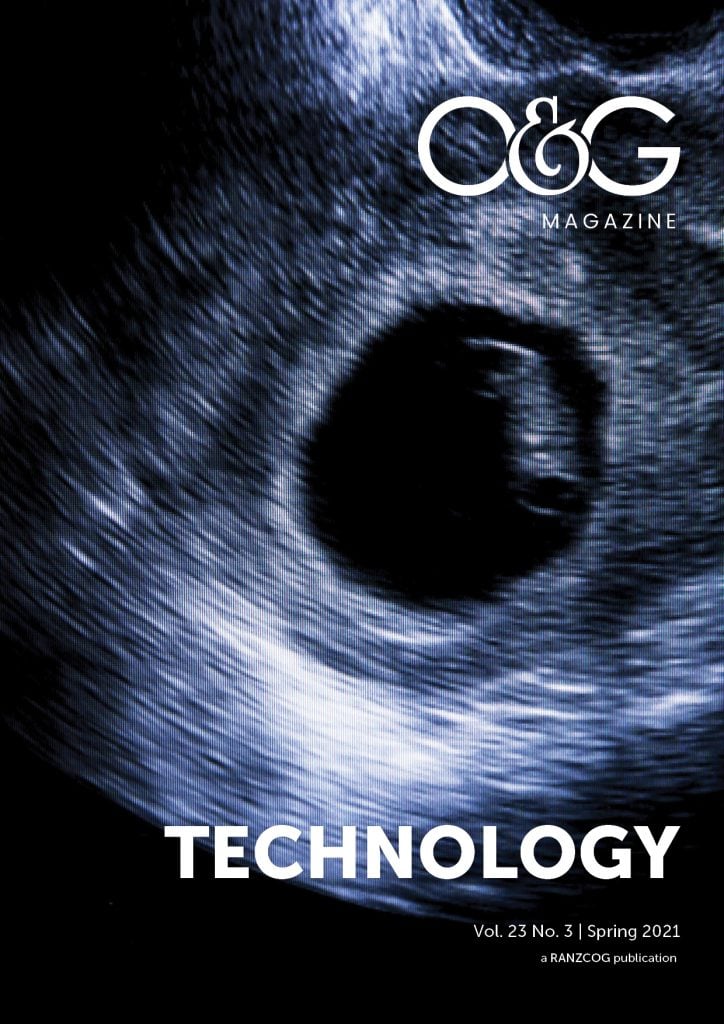For the broader O&G Magazine readership, Q&A seeks balanced answers to those curly-yet-common questions in obstetrics and gynaecology.
How would you assess and manage the patient who presents with abdominal trauma in the third trimester?
Trauma is the leading non-obstetric cause of maternal mortality and morbidity, occurring in 8% of all pregnancies. Motor vehicle accidents (MVA) are the most commonly reported abdominal trauma. Fetal injury resulting from trauma can be classified as direct or indirect (Table 1). Direct trauma can attribute to fractures of the spine and skull, haemorrhage from injury to extremities or intracranial haemorrhage and organ ruptures. Direct trauma can compromise maternal physiology. Indirect trauma in this table is defined as trauma that has occurred secondary to the direct trauma. Fetal compromise can be present without obvious maternal injury
Abdominal trauma needs immediate evaluation to determine the severity of the trauma. Minor trauma accounts for 90% of the trauma presentations and 25% of the fetal deaths from abdominal trauma in third trimester. 10% are considered major with only 2% requiring surgical intervention.
Primary obstetric survey should be conducted on presentation with escalation to consultants as required. All hospitals should have effective triage systems allowing rapid detection of irregular observations with escalation protocols. All staff should understand the physiological changes of pregnancy – cardiovascular, haematologic, respiratory and gastrointestinal – in order to provide a systematic evaluation, as the severity of maternal injury directly relates to fetal compromise.
Always remember there are two patients: maternal and fetal. Remember that maternal resuscitation is paramount and needs to be first priority. A multidisciplinary team approach for primary survey has shown better maternal and fetal outcomes. Rapid maternal resuscitation ultimately reduces risk to the fetus. As pregnancy progresses, the associated physiological changes become more significant and the abdominal anatomy becomes distorted. A patient could lose up to 30% of total volume prior to any signs of shock. Serious maternal injury may indicate the need for perimortem caesarean; if needed this must be acted upon quickly.
Table 1. Causes of third trimester abdominal trauma.
| Direct | Indirect (resulting from direct trauma) |
|
|
Management at the primary survey
Management is determined on the mechanism of injury and clinical findings. Primary survey allows immediate management of life-threatening abdominal trauma via resuscitation and surgical intervention as needed.
Once patient stable, secondary survey is mandatory to determine obstetric and non-obstetric injuries, the level of assessment, and investigations needed for further management.
| Primary obstetric survey | Perimortem caesarean |
| DR ABC E TILT
Danger Uterine displacement as alternative to TILT when cardiac compressions, intubation are required. |
Indicated – maternal cardiac arrest. Gravid uterus above umbilicus or >20 weeks Up to 30 mins after cardiac arrest commenced. Lie patient supine – increases effective cardiac compressions. Removes pressure for IVC/aorta Decrease preload Improves lung volume compliance Reduces maternal oxygen demand Increased chance of maternal and fetal survival |
Secondary survey
Firstly, determine the mechanism of Injury and obtain a full antenatal history followed by a full evaluation of maternal and fetal condition, keeping in mind the differential diagnosis of third trimester abdominal trauma.
Vitals
Blood pressure, pulse, temperature, pain, oxygen saturations, ECG.
Remember to consider the physiological changes of third trimester.
Bloods
FBC, Group and hold, LFT. Coags, kleihauer-Betke,Lipase Coags + ROTEM ( Rapid assessment of clotting) urine.
Positive Keilhauer-Betke indicates fetal-maternal haemorrhage. Remember that anti-D should be given to all Rh-negative mothers in third trimester. Continue regular monitoring.
CTG
It is recommended that a minimum of four hours of CGT monitoring be conducted for all presentations with third trimester abdominal trauma. Placenta abruption can occur over time; therefore, CTG may be indicated up to 24 hours post injury. If CTG is abnormal, consider immediate delivery. If labour has commenced, do not treat with tocolytics. If preterm, treat with Betamethasone, magnesium sulphate. If necessary, transfer to a secondary or tertiary centre
Examination should be done with consent and chaperone if possible.
Abdominal palpation
Look for tenderness, contractions, rigidity, injury. Bruising. Seat belt marks. Always look for evidence of domestic violence.
Speculum
Check for vaginal bleeding, evidence of trauma or sexual assault, determine cervical dilatation and perform high vaginal and low vaginal swabs, wound swabs, amnisure and fetal fibronectin, depending on the clinical scenario.
Vaginal examination
Conduct only when necessary and rarely for preterm presentations. Do not perform unless you have checked ultrasound scans for vasa praevia, placenta praevia.
Vaginal bleeding and/or uterine tenderness can indicate abruption, especially in trauma cases.
Imaging
Ultrasounds, CT scans and MRI should be done as indicated. Informed consent should be sought In acute cases. Imaging should be priority while awaiting lab results. A follow-up ultrasound should be done within two weeks on all trauma obstetric patients needing admission.
Management
Management is determined upon history and examination findings as well as clinical expertise and available resources. If delivery is needed and is not urgent, consider the gestational age. If <34 weeks, give Betamethasone 11.4 IU, 12–24 hours apart, with escalation to consultant, theatre, anaesthetics, paediatrics, ICU, as required. Consider delivery vaginal or LUSCS, consider need for transfer, consider stability of the patient. If delivery is not urgent, determine outpatient verses inpatient management and the timing of future monitoring such as antenatal visits, ultrasounds, repeat bloods and delivery. Remember to escalate as situations change and always document everything.
Further reading
- Murphy NJ, Quinlan JD. Trauma in pregnancy: Assessment, management, and prevention. Am Fam Physician. 2014;90(10):717–22.
- Gumm K, Kennedy M, Oats J, et al. TRM 05.01 Pregnancy and Trauma Guideline. Trauma Service Guidelines. 2006;1–14.
- Vaynshtein J, Guetta O, Replyansky I. Abdominal Pain in Pregnancy. JAMA Surg. 2019;154(2):176–7.
- Guideline QC. Quennsland Clinical Guideline: Trauma in pregnancy. Queensland Health. 2019. Available from: www.health.qld.gov.au/qcg
- Greco PS, Day LJ, Pearlman MD. Guidance for Evaluation and Management of Blunt Abdominal Trauma in Pregnancy. Obstet Gynecol. 2019;134(6):1343–57.
- Barraco RD, Chiu WC, Clancy TV, et al. Practice management guidelines for the diagnosis and management of injury in the pregnant patient. J Trauma – Inj Infect Crit Care. 2010;69(1):211–4.
- Jain V, Chari R, Maslovitz S, et al. Guidelines for the Management of a Pregnant Trauma Patient. J Obstet Gynaecol Canada. 2015;37(6):553–71.
- Berlingieri P, Grudzinskas JG. Assessment of abdominal pain in pregnancy. BMJ Best Pract. 2018; Available from: http://bestpractice.bmj.com/best-practice/monograph/664/diagnosis/differential-diagnosis/by-category.html
- Woodhead N, Nkwam O, Caddick V, et al. Surgical causes of acute abdominal pain in pregnancy. Obstet Gynaecol. 2019;21(1):27–35.
- Samberkar PN, Chow TK, Samberkar SP. Fatal spontaneous rupture of splenic artery aneurysm in third trimester pregnancy. Malays J Pathol. 2018;40(3):337–41.
- Chavan NN, Rohidas V, Waikule H. Accidental haemorrhage in third trimester: maternal and fetal outcome. Int J Reprod Contraception. Obstet Gynecol. 2019;8(4):1633.
- Bouyou J, Gaujoux S, Marcellin L, et al. Abdominal emergencies during pregnancy. J Visc Surg. 2015;152(6):S105–15.
- Lien C, Ali A, Culhane J. Blunt abdominal trauma with uterine rupture and fetal demise. Journal of Trauma. 2017;19(3):219-221.
- Brookfield K G-QV, Davis J, Schulman C. Maternal death in the emergency department from trauma. Archives of Gynecology and Obstetrics. 2013;288:507-512.
- ANZCOR. Management of Cardiac Arrest due to Trauma; ANZCOR Guideline 11.10.1: Australian and New Zealand Council of Resusitaiton April 2016.
- Judson R, Liersch K. TRM 08.07 Xray imaging during pregnancy 4 ed. Melbounre: The Royal Melbourne Hospital Trauma Service; 2017.
- Mendez-Figueroa H, Dahlke J, Vrees R, Rouse D. Trauma in pregnancy: an updated systematic review. American Journal of Obstetrics & Gynecology. July 2013;209(1):1-10. 33.
- Lien C, Ali A, Culhane J. Blunt abdominal trauma with uterine rupture and fetal demise. Journal of Trauma. 2017;19(3):219-221.
- Services DoHaH. Perinatal mortality review process. Victoria: State Government of Victoria; 2017.
- Petrone P, Marini C. Trauma and pregnant patients. Current Problems in Surgery 2015;52:330-351.
- Surgeons ACo. Trauma and Pregnancy and Intimate Partner Vilolence. In: Trauma Co, ed. ATLS®, Advanced Trauma Life Support®, Student Course Manual 10 th ed. Chicago; USA. American College of Surgeons. 2018 226-239.
- Mendez-Figueroa H, Dahlke J, Vrees R, Rouse D. Trauma in pregnancy: an updated systematic review. American Journal of Obstetrics and Gynecology. 2017;209(1).






Leave a Reply